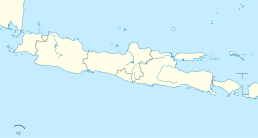Candi Sewu
| Sewu Temple Compound (Manjusrigrha) | |
|---|---|

The Sewu temple compound
|
|
|
Location within Java
|
|
| General information | |
| Architectural style | Buddhist candi |
| Town or city | Klaten Regency, Central Java |
| Country | Indonesia |
| Coordinates | 7°44′37″S 110°29′37″E / 7.7435°S 110.4935°E |
| Completed | circa 8th century |
| Client | Sailendra or Mataram Kingdom |
Sewu is an eighth century Mahayana Buddhist temple located 800 meters north of Prambanan in Central Java. The word for a Hindu or Buddhist temple in Indonesia is "candi." And Candi Sewu is the second largest Buddhist temple complex in Indonesia; Borobudur is the largest. Sewu predates nearby "Loro Jonggrang" temple at Prambanan. Although the complex consists of 249 temples, this Javanese name translates to 'a thousand temples,' which originated from popular local folklore (The Legend of Loro Jonggrang). Archaeologists believe the original name for the temple compound to be Manjusrigrha.
According to the Kelurak inscription (dated from 782 CE) and the Manjusrigrha inscription (dated from 792 CE), which were discovered in 1960, the original name of the temple complex was probably "Manjusri grha" (The House of Manjusri).Manjusri is a Bodhisattva from Mahayana Buddhist teachings that symbolizes the "gentle glory" of transcendent wisdom (Sanskrit: prajñā). Sewu Temple was built by the end of eighth century at the end of Rakai Panangkaran's reign and was completed during the reign of his successor, King Indra. Rakai Panangkaran (746—780 CE) was well known as a devoted Mahayana Buddhist king who ruled the Medang Mataram Kingdom.
...
Wikipedia

